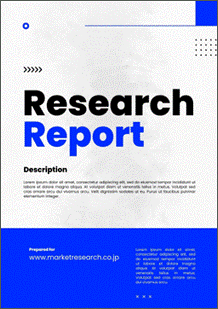 | • レポートコード:D0-MOR-AP0060 • 出版社/出版日:Mordor Intelligence / 2020年4月20日 • レポート形態:英文、PDF、110ページ • 納品方法:Eメール(受注後2-3営業日) • 産業分類:食品&飲料 |
| Single User | ¥629,000 (USD4,250) | ▷ お問い合わせ |
| Team User | ¥703,000 (USD4,750) | ▷ お問い合わせ |
| Corporate License | ¥1,110,000 (USD7,500) | ▷ お問い合わせ |
• お支払方法:銀行振込(納品後、ご請求書送付)
レポート概要
| 本調査レポートは、アルコール成分の世界市場について調査・分析した資料で、アルコール成分の市場概要、動向、セグメント別市場規模、地域別分析、競争状況、企業情報、市場機会分析などで構成されています。 |
Global alcohol ingredients market is projected to grow at a CAGR of 9.6% during the forecast period (2019 – 2024).
– The consumption of alcohol across the globe has increased a faster pace in the past couple with 235.4 billion liters of alcohol consumed in 2017 (Survey conducted by Banco do Nordeste), which in turn has paved way for the ingredient manufacturers to increase their production facility to meet the burgeoning demand coming for alcoholic beverage industries.
– Moreover, the consumers are increasingly inclining towards craft beer which has resulted in an increasing number of craft breweries across the globe with the highest number of outlets in the United Kingdom followed by Germany, Italy, and others. This is yet another factor driving the alcohol ingredients market across the globe.
Key Market Trends
Increasing Demand For Craft Beer
Craft beer has gained popularity among a large section of the consumers. The millennial population has been a key factor for the rapid sales of craft beers across the globe. Factors affecting the shift toward craft beer consumption are demand for variety, taste for flavor, and beer quality, among others. Craft brewers are beacons of innovation, revitalization, and collaboration. For instance, The Boston Beer Company expanded its Samuel Adams beer brand with the launch of Sam ’76, a union of lager and ale. A base lager and a base ale – each with its own respective yeast strains.
Asia-Pacific Remains the Fastest Growing Region
Asia-Pacific, in particular, holds immense potential for the craft beer market, with robust demand for Westernized craft beer that is blended with local taste and preferences. Shift in consumer preferences from traditional alcohol toward imported alcohol has been one of the driving factors for the growth of the alcoholic beverage market in the region. In countries like China, consumers are inclined toward wines manufactured by famous vineyard regions, such as Bordeaux, owing to renowned heritage and prestige. Whiskies, cognacs, and imported wines are becoming popular across the region as consumers are more inclined toward premium products.
Competitive Landscape
The global alcohol ingredient market is highly fragmented due to the dominance of several local and global players present in the market. Nonetheless, the market exhibits a strong presence of global key players, such as DSM, ADM, Cargill and Döhler Group, alongside other domestic producers. Expansion remained the most adopted strategy among malt ingredient manufacturers, holding a major chunk of total strategies, followed by product innovation, partnership, and merger and acquisition. The major players are expanding their production capacities and strategically planning to supplement their export facilities, in order to stand out among other manufacturers in the market.
Reasons to Purchase this report:
– The market estimate (ME) sheet in Excel format
– Report customization as per the client’s requirements
– 3 months of analyst support
1 INTRODUCTION
1.1 Study Deliverables
1.2 Study Assumptions
1.3 Scope of the Study
2 RESEARCH METHODOLOGY
3 EXECUTIVE SUMMARY
3.1 Market Overview
4 MARKET DYNAMICS
4.1 Market Drivers
4.2 Market Restraints
4.3 Porter’s Five Forces Analysis
4.3.1 Threat of New Entrants
4.3.2 Bargaining Power of Buyers/Consumers
4.3.3 Bargaining Power of Suppliers
4.3.4 Threat of Substitute Products
4.3.5 Intensity of Competitive Rivalry
5 MARKET SEGMENTATION
5.1 By Ingredient Type
5.1.1 Yeast
5.1.2 Enzymes
5.1.3 Colorants
5.1.4 Flavors & Salts
5.2 By Bevrage Type
5.2.1 Beer
5.2.2 Spirits
5.2.3 Wine
5.2.4 Whisky
5.2.5 Brandy
5.3 Geography
5.3.1 North America
5.3.1.1 United States
5.3.1.2 Canada
5.3.1.3 Mexico
5.3.1.4 Rest of North America
5.3.2 Europe
5.3.2.1 Spain
5.3.2.2 United Kingdom
5.3.2.3 Germany
5.3.2.4 France
5.3.2.5 Italy
5.3.2.6 Russia
5.3.2.7 Rest of Europe
5.3.3 Asia Pacific
5.3.3.1 China
5.3.3.2 Japan
5.3.3.3 India
5.3.3.4 Australia
5.3.3.5 Rest of Asia-Pacific
5.3.4 South America
5.3.4.1 Brazil
5.3.4.2 Argentina
5.3.4.3 Rest of South America
5.3.5 Middle East and Africa
5.3.5.1 South Africa
5.3.5.2 United Arab Emirates
5.3.5.3 Rest of Middle East and Africa
6 COMPETITIVE LANDSCAPE
6.1 Most Active Companies
6.2 Most Adopted Strategies
6.3 Market Share Analysis
6.4 Company Profiles
6.4.1 Archer Daniels Midland Company
6.4.2 Cargill
6.4.3 Koninklijke Dsm N.V
6.4.4 Dohler Group
6.4.5 Chr Hansen
6.4.6 Sensient Technologies Corporation
6.4.7 Ashland Inc.
6.4.8 D.D. Williamson & Co., Inc.
7 MARKET OPPORTUNITIES AND FUTURE TRENDS